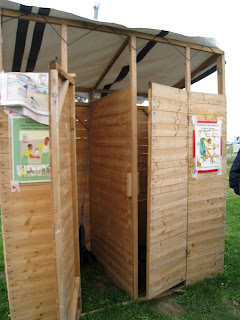I went to the Doctors Without Borders/Medicins Sans Frontieres (MSF) campsite on the coldest and cloudiest day of the week and I was impressed with the people who stood in line and braved the Golden Gate winds for 1.5 hours of the outdoor walking tour. I’m glad the MSF camped in San Francisco's backyard, although its ironic the Marina backyard is known for its yachts, yuppy cars and ginormous apartment rentals . Dolores Park would have been more appropriate or in front of City Hall where they recently had a vegetable garden display.
MSF is a non-profit, non-governmental organization that provides humanitarian assistance (medical treatment, disease prevention, sanitation treatment, counseling, food and shelter) to the 42 million refugees and displaced persons in more than 60 countries. Instead of reading the statistics or watching the brief TV news reports (if any), MSF setup the site to showcase real life situations of a refugee.
My guide was a nurse who worked in refugee camps in Southeast Asia. It definitely looked like a bare bones campsite with various styled living tents constructed from material of the native environment whether from bamboo found in Southeast Asia or used leftover metal and wood used in this dwelling from South America.
She first explained to my group of 10 people which included two school age children, the definition and difference between a refugee and an internally displaced person (IDP). I didn’t know there was another category besides refugees until that day. A refugee is a person who escapes his/her country to another for safety due to war, conflict or persecution. Under international laws, the new host country provides protection and assistance. Our guide said there are 16 million refugees.
But an IDP who is unable to travel to another country, stays within his country’ borders, therefore lacking civil, medical and health protection from MSF and other humanitarian help since it’s not required by law. These organizations have tried to help but they risk endangering their own lives as well due to lack of international protection. There are 26 million IDP’s, more than half are in six countries.


We then proceeded to a volunteer posing as the guard commanding over the entrance gate to the campsite where we showed what little possession we were bringing. We’re told that refugees usually enter the site with hardly anything of their original belongings due to space limitations. Once inside, we stepped into the first tent which would fit at least 20 people. 

The two kids in
Our next step was the outdoor water intake and filtering system. We have the luxury of not seeing our water collected, processed and then measured for limited use. From the source to the five gallon jug, this is all that a person is given per day for their use: bathing, washing, cooking, and drinking. Can you imagine
Then we went to the latrines. Walk inside and watch your step. Literally. There’s no basin just a hole in the ground. A gray plastic mat simulated a pair of feet and the hole. A container would be underneath the hole would be a container and emptied and disinfected. Picture yourself squatting with no support underneath and around you. Imagine a child who’s smaller than the circumference of the hole. Our guide told us many children were afraid to use the latrine because they were understandably afraid of falling in.
The latrine and the next stop of the tour, the medical tent, struck me the most. We’ve seen news footage of bony emaciated babies, ribs stuck to their dry shriveled skin, belly’s ballooned to disfigurement, sunken eyes with no glimmer of hope. In order to quickly medically assess how malnourished a child is, a nurse wraps a band around a child’s forearm and measures its circumference. The bigger the hole, the better the child’s chances for survival. This tiny ho le means death is imminent and the child needs ASAP attention. I couldn’t insert two fingers through the hole. But even at this point, there's still a slim chance that a life can still be saved. This child’s arm fit easily into hole. A year later, he’s smiling and healthy.
le means death is imminent and the child needs ASAP attention. I couldn’t insert two fingers through the hole. But even at this point, there's still a slim chance that a life can still be saved. This child’s arm fit easily into hole. A year later, he’s smiling and healthy.
I was hungry and freezing when the tour ended. Woe is me. I quickly walked to my car looking forward to blasting my heater. How easy and convenient that I can adjust my comfort wherever, however and whenever . As I walked on the lush green lawn, I didn’t have to carefully tiptoe around hundreds of hidden land mines. Marina Safeway is just a 2 minute drive away and I can buy any type of food and as much as I want. I don
My bathroom is comfortable and clean and I don’t have to worry about hundreds of people using it every day, spreading disea
I walked away from the site realizing how fortunate I really am, despite the country's economic crisis. I’m grateful MSF took the time, expense and effort to educate San Francisco. They practice what they preach and spreading the word of a refugees struggle opened my eyes. Los Angeles is their next tour of duty. I hope the City of Angels embraces the MSF angels and experience humility, insight, respect and understanding of the 42+ million refugees as the Baghdad By the Bay did.







Comments